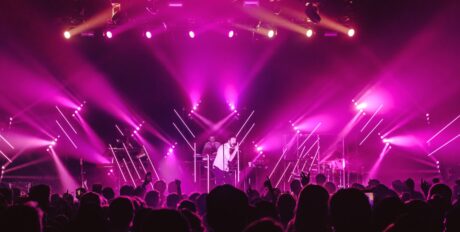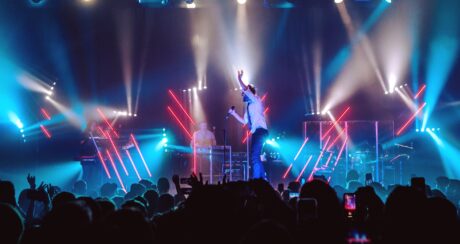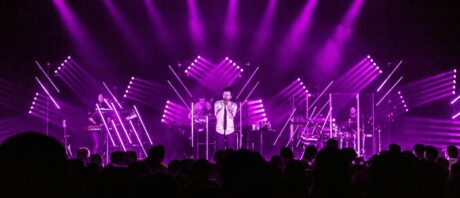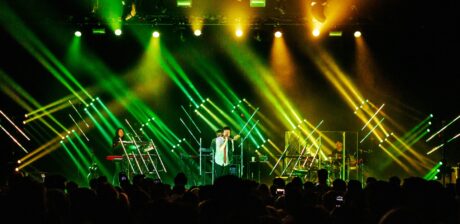
NEW YORK – Sam Parker describes the look he devised for Passion Pit’s just-concluded Manners 10th Anniversary Tour as resembling a “space station command pit.” Like an inter-galactical craft, which turns reality on its head as it approaches the speed of light and enters the darker realm of quantum physics, Parker’s rig expanded creative horizons by overthrowing the obvious.
More details from Chauvet (www.chauvetprofessional.com):
Michael Angelako can attest to that!

The charismatic lead singer for Passion Pit, Angelako has never felt comfortable with asymmetrical production designs. So, he was less than enthused when he saw what Parker had created for the popular electro indie band’s North American tour. His rig, which was supplied by Squeek Lights, was anchored by three pods holding collections of CHAUVET Professional Rogue R1 FX-B and EPIX Strip Tour fixtures in very different configurations.
“At first there was maybe a small panic on his part, because of the asymmetrical design,” said Parker. “But once I showed him the ‘symmetry’ that laid within our asymmetrical design, he thought it was a really great new look. This made him excited, since Passion Pit hadn’t tried something new with their lighting for some time.”

Parker worked this convention-defying magic by altering the direction of light from the five independent moving heads on his Rogue fixtures, and by creating movement with video images on his EPIX units. This allowed him to endow his asymmetrical design with a harmoniously balanced look.
“For this design I had 30 EPIX Strips and 16 R1 FX-B’s,” detailed Parker. “I made three pod-like space stations in front of the three band members that support the lead singer. Each pod had a wooden base with an almost handrail-like pipe design. The three pods were asymmetrical, with the two outside stations having five EPIX Strips arranged in a diagonal, asymmetrical shape, and the center pod having four straight and vertical EPIX Strips.
In addition to the three pods, Parker used an intricate tower arrangement to create a powerful patterned effect on stage. He had six pipe and base towers upstage, one downstage left and one downstage right. Each tower had two side arms on the pipe and base. The top arms on these towers faced on-stage, while the bottom arms faced off-stage. A Rogue R1 FX-B fixture was hung yoke-out from each arm.
“There was about two and a half feet of space between the top FX-B and the bottom FX-B,” said Parker. “I also had two EPIX Strips placed at a hard diagonal attached. The stage left and stage right strips were positioned to face the opposite on one another. Taken together, this gave me a very multi-dimensional look that expanded the design in keeping with the galaxy theme.”

To reinforce this celestial impression, Parker displayed space-inspired video content on his EPIX Strip Tour units. “Even though the fixtures were stationary because of the pods and the configuration we positioned them in, we got the feeling of a moving space station through the video content,” he said.
Parker added to the dimensionality of his design by varying the specific heads in his Rogue R1 FX-B fixtures that he had illuminated at any one time. “With each fixture having five moving heads, it looked like I had 60 lights going, even though I had only 16,” he said. “We had so many different combinations of heads on at different times that we created the impression of this being a really big rig. For a subtle song like Swimming in the Flood, I used pixels 2 and 4 mostly, but then I would introduce the missing pixels 1, 3, 5, and tilt them in opposite directions. For other songs like Moth’s Wings, I had these lights looking like beams.”
Considering his lightshow from the perspective of the audience, Parker says that it would be easy to think that all of the different looks created by the Rogue R1 FX-B were coming from a variety of different types of light. In reality, though, they all emanated from only one type of fixture. This “illusion” was representative of Parker’s design process, which called for reconfiguring visual elements to make them appear different, and in the process reveal something that went beyond everyday reality in its impact.
Photo Credit: Sarah Hess


